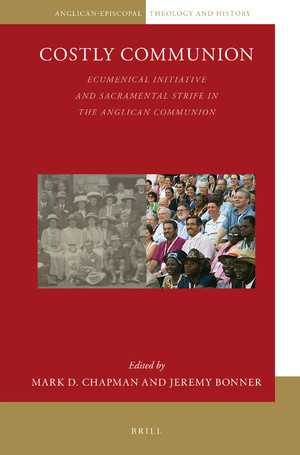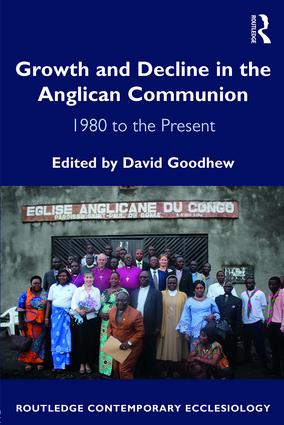Review: Miranda K. Hassett, Anglican Communion in Crisis: How Episcopal Dissidents and Their African Allies are Reshaping Anglicanism. (Princeton: Princeton University Press, 2007).
Miranda Hassett has set herself a challenging task, yet the result is worthy of wide scrutiny, by liberal and conservative alike. Indeed, the title of this book combined with the author’s forthright disclosure that she is both a liberal Episcopalian and an anthropologist, makes her balanced treatment of the subject matter all the more commendable.
Central to Hassett’s approach is her understanding of globalization not as an impersonal and irresistible force but as a process shaped by human agency. Conservatives – religious and otherwise – have traditionally been understood as hostile to globalization; yet Episcopal conservatives have recently learned to cultivate transnational networks with Third World provinces that have resulted in a process of shared identity. At one point, Hassett contrasts what she calls diversity globalism (as espoused by liberal scholars like Ian Douglas) with the new accountability globalism: “Accountability globalism is a true globalism . . . This is no veiled anti-globalism or reactionary vision, in which the older authority structures of white male Euro-American dominance are reestablished to maintain order in an increasingly complex worldwide organization. Instead, this conservative vision embraces the diversity and complexity of the contemporary world.” (127)
Hassett is also concerned with the construction of relationships, a very necessary part of the call to discipleship. To study the phenomenon, she elected to spend four months in an Anglican Mission in America (AMIA) parish, pseudonymously dubbed St. Timothy’s, and six months in central Uganda observing how the patterns of global relationship and self-understanding had been transformed by the evolving crisis within the Anglican Communion. In accordance with anthropological practice, except for statements in published sources, all the testimony in the narrative is anonymous. While this may seem strange at first glance, it comports with the tradition of rural American sociology popularized in the 1920s by scholars like Edmund Brunner, and has the added advantage of freeing her subjects to express exactly what they are feeling.
The case of St. Timothy’s is itself fascinating in that it traces a distinct paradigm shift in how the transnational perspectives of affluent middle class Americans have been transformed by the development of ties to Africa that are not based solely on First World largesse. Hassett describes how St. Timothy’s followed the not untypical renewal pattern of the 1980s, developing a charismatic style and attracting evangelicals who had not been raised within the Episcopal Church. For many, Rwanda had not been on their radar, even during the 1994 genocide, and when they joined AMIA in 2000, their principal concern had been to escape from the Episcopal Church. Yet in the years that followed, there has grown up an identification with the Anglicans of Rwanda that is much deeper and is predicated on a better understanding of the essence of the Rwandan Church. Hassett describes how a group who undertook a mission to Rwanda expected to be besieged with requests for material assistance, only to learn that what their hosts most desired was simply to begin to build a relationship. (162-65)
In examining the origins of the conservative movement in the Episcopal Church, Hassett challenges some widespread opinions held by members of the liberal community. The oft-repeated charge that the support of Global South bishops for American conservatives at the 1998 Lambeth Conference and subsequently was “bought,” she dismisses as reflecting an inadequate grasp of where most of the Southern bishops stood. That there are problems with the disparities of wealth between North and South and how wealth is shared between the two cannot, she believes, explain why the crisis has developed as it has done. More controversial, especially in America, will be the conclusion she draws from her experience of worshipping and talking with members of St. Timothy’s, regarding the genuineness of the professions of concern for moral teaching that come from groups like AMIA. “Although homosexuality is often singled out for particularly vehement opposition,” she writes, “my time at St. Timothy’s showed me that evangelical Episcopalians’ responses to homosexuals are framed in the same language of sin and the need for transformation through a relationship with Jesus Christ that they apply to their own lives.” (42)
Conservatives, however, should not become complacent. Hassett has her own view of the myth that has grown up around Philip Jenkins's The Next Christendom, which has led some to see the shift in the locus of power to the Global South as the inevitable triumph of Christian orthodoxy. (249-52) Her Ugandan experiences demonstrate that the sense of a monolithic Southern Church that one can sometimes derive from the statements of certain primates is far from accurate. She notes, for example, the greater degree of tolerance for homosexuality (though not a denial of its sinful nature) displayed by the Bakolole fellowships that emerged from the East African Revival; the understanding of homosexuality as an imported “colonial” practice that has made it a matter of nationalist well as religious significance; and the continued reservations expressed by Ugandan bishops and priests about the wisdom of constituting AMIA.
Perhaps most interesting of all, in her discussion of conservative idealization of Africa, is Hassett’s exploration of the five key themes of youth; zeal; numbers; suffering; and poverty. (177-97) Her objective here is not to claim that the points raised are wholly invalid but that they are often projections of what conservative Northerners expect to see rather than what those who are enduring them actually experience. Ugandans continue to worry about “nominal” Christians and the superficiality of belief, dislike the notion that their continent should so often be portrayed in terms of chaos and destruction, and fear that endemic poverty, far from producing a stronger faith may actually weaken it. “Conceiving of African Christians as people of pure and simple faith,” concludes Hassett, “invokes concepts ultimately derived from older and negative views of Africans as childlike, primitive and uncivilized. To be sure, these negative images have now been turned on their heads to become idealizations, but the fundamental idea of African otherness carries on unimpeded into the new romanticized images.’ (205)
This book points a way forward in terms of understanding the implications of globalism for the ever-expanding Anglican family and the patterns of relationship that are being developed to transcend physical barriers. Comparable studies of parishes affiliated with CANA, as well as of conservative parishes still within the Episcopal Church, would be a valuable addition to the literature, as would parish-level studies of diversity globalism and how liberal Anglicans understand it. “My account of current debates in the Anglican tradition will no doubt be contested;” notes Miranda Hassett, “my hope is that people on all sides of the current debates will find an equal measure in these texts with which to take issue.” (22) As far as this moderately conservative Anglican is concerned, she has more than achieved her goal.









